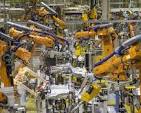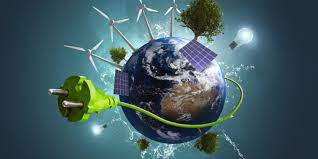Energy and AI: Transforming the Future of Power
The intersection of energy and artificial intelligence (AI) is revolutionizing how we produce, distribute, and consume power. With the growing demand for sustainable energy solutions, AI is playing a crucial role in optimizing operations, reducing waste, and enhancing efficiency across the energy sector.
AI in Energy Production
AI technologies are being integrated into various stages of energy production to enhance efficiency. In renewable energy sectors like wind and solar power, AI algorithms help predict weather patterns and optimize the positioning of turbines or solar panels for maximum output. This not only improves energy production but also reduces costs associated with maintenance and downtime.
Smart Grids and Distribution
One of the most significant applications of AI in the energy sector is in the development of smart grids. These grids use AI to analyze data from various sources to balance supply and demand efficiently. By predicting peak usage times and adjusting distribution accordingly, smart grids help prevent outages and reduce energy waste.
Energy Consumption Optimization
AI is also transforming how consumers use energy. Smart home devices equipped with AI can learn user habits to optimize heating, cooling, and lighting systems for better energy conservation. For businesses, AI-driven analytics provide insights into consumption patterns, allowing for more precise management of resources.
Predictive Maintenance
A key benefit of integrating AI into the energy sector is predictive maintenance. By analyzing data from equipment sensors, AI can predict when machinery might fail or require servicing. This proactive approach minimizes downtime and extends the lifespan of equipment, leading to significant cost savings.
The Role of Machine Learning
Machine learning, a subset of AI, plays a vital role in advancing these technologies. By processing vast amounts of data quickly and accurately, machine learning algorithms can identify patterns that humans might miss. These insights lead to more informed decision-making processes across all aspects of the energy industry.
Challenges and Opportunities
While the integration of AI in the energy sector presents numerous opportunities for innovation and efficiency gains, it also poses challenges such as data privacy concerns and the need for robust cybersecurity measures. Addressing these issues will be essential as we continue to rely more heavily on digital technologies for our power needs.
The Future Outlook
The future looks promising as advancements in AI continue to drive progress in sustainable energy solutions. By further integrating AI technologies into every facet of the energy industry—from production to consumption—we can move towards a more efficient, reliable, and environmentally friendly global power system.
The synergy between energy and artificial intelligence holds immense potential for transforming how we harness power today while paving the way for a greener tomorrow.
7 Ways AI Revolutionizes Energy Efficiency and Management
- Utilize AI for optimizing energy consumption in buildings.
- Implement AI algorithms to forecast energy demand more accurately.
- Use AI for predictive maintenance of energy infrastructure to prevent breakdowns.
- Employ machine learning models to analyze and improve renewable energy production efficiency.
- Incorporate AI into smart grids for better management of electricity distribution.
- Apply AI in energy trading to optimize buying and selling decisions.
- Explore the use of AI-powered drones for inspecting power lines and infrastructure.
Utilize AI for optimizing energy consumption in buildings.
Utilizing AI for optimizing energy consumption in buildings is a groundbreaking approach to enhancing efficiency and sustainability. AI systems can analyze data from various sensors and smart devices within a building to understand usage patterns and identify areas for improvement. By learning from historical data, these systems can predict energy needs and automatically adjust heating, cooling, lighting, and other systems in real time to reduce waste. This not only leads to significant cost savings on utility bills but also contributes to reducing the building’s carbon footprint. Furthermore, AI-driven energy management solutions can provide actionable insights that help facility managers make informed decisions about upgrades and maintenance, ensuring optimal performance and comfort for occupants while promoting environmental responsibility.
Implement AI algorithms to forecast energy demand more accurately.
Implementing AI algorithms to forecast energy demand more accurately is a game-changer for the energy sector. These algorithms analyze vast amounts of data, including historical consumption patterns, weather conditions, and economic indicators, to predict future energy needs with remarkable precision. By providing utilities with these insights, AI enables them to optimize resource allocation, reduce waste, and prevent overproduction. This not only leads to cost savings but also enhances grid stability and reliability. Furthermore, accurate demand forecasting supports the integration of renewable energy sources by ensuring that supply matches demand even as variable resources like wind and solar fluctuate. Overall, AI-driven demand forecasting is a crucial step towards creating a more efficient and sustainable energy system.
Use AI for predictive maintenance of energy infrastructure to prevent breakdowns.
Utilizing AI for predictive maintenance of energy infrastructure is a game-changer in preventing breakdowns and ensuring efficient operations. By deploying AI algorithms that analyze data from sensors embedded in equipment, energy companies can identify patterns and anomalies indicative of potential failures. This proactive approach allows for timely maintenance and repairs before issues escalate into costly breakdowns. Predictive maintenance not only extends the lifespan of critical infrastructure but also minimizes downtime, enhances safety, and reduces operational costs. As a result, energy providers can deliver more reliable services to consumers while optimizing their resources and contributing to a more sustainable energy future.
Employ machine learning models to analyze and improve renewable energy production efficiency.
Employing machine learning models to analyze and improve renewable energy production efficiency is a game-changer for the industry. These models can process vast amounts of data from various sources, such as weather forecasts, equipment performance metrics, and historical energy output. By identifying patterns and predicting future conditions, machine learning algorithms enable operators to optimize the placement and operation of renewable energy assets like wind turbines and solar panels. This leads to more consistent energy production, reduced downtime, and lower maintenance costs. Ultimately, leveraging machine learning in this way not only enhances the efficiency of renewable energy systems but also contributes to a more sustainable and reliable energy future.
Incorporate AI into smart grids for better management of electricity distribution.
Incorporating AI into smart grids significantly enhances the management of electricity distribution by making the system more efficient and responsive. AI algorithms can analyze vast amounts of real-time data from various sensors and meters across the grid, allowing for precise predictions of energy demand and supply fluctuations. This capability enables utilities to optimize the flow of electricity, reducing waste and preventing overloads. Additionally, AI can identify patterns in energy usage and anticipate potential issues before they escalate into outages, ensuring a more reliable power supply. By facilitating dynamic adjustments to electricity distribution, AI-driven smart grids contribute to a more sustainable and resilient energy infrastructure.
Apply AI in energy trading to optimize buying and selling decisions.
Applying AI in energy trading can significantly enhance the decision-making process for buying and selling energy. By leveraging advanced algorithms and machine learning models, AI can analyze vast amounts of market data in real-time to identify trends, forecast prices, and assess risks more accurately than traditional methods. This enables traders to make more informed decisions, optimize their trading strategies, and ultimately maximize profits while minimizing losses. Furthermore, AI can help identify arbitrage opportunities by detecting price discrepancies across different markets or timeframes, allowing traders to capitalize on these differences. As the energy market becomes increasingly complex and volatile, integrating AI into trading practices offers a competitive edge by improving efficiency and precision in executing trades.
Explore the use of AI-powered drones for inspecting power lines and infrastructure.
The use of AI-powered drones for inspecting power lines and infrastructure is an innovative approach that enhances the efficiency and safety of maintenance operations. These drones are equipped with advanced sensors and cameras that can capture high-resolution images and data, which AI algorithms analyze to detect potential issues such as corrosion, damage, or vegetation overgrowth. By automating the inspection process, utility companies can significantly reduce the time and cost associated with manual inspections while minimizing risks to human workers. Additionally, AI-powered drones can access hard-to-reach areas more easily than traditional methods, ensuring comprehensive coverage and more accurate assessments of infrastructure health. This proactive approach allows for timely maintenance interventions, reducing the likelihood of outages and improving the overall reliability of power systems.



